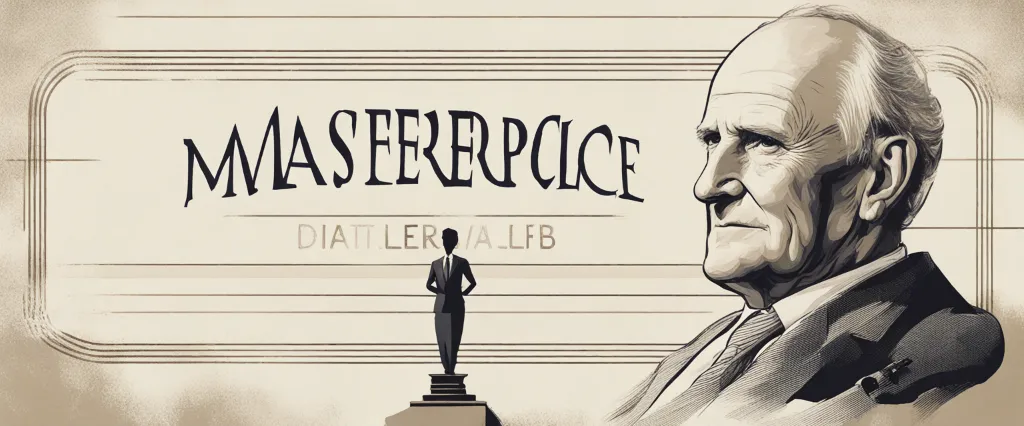In the highly acclaimed and thought-provoking book “Winning,” renowned business executive and former CEO of General Electric, Jack Welch, combines his extensive leadership experience with insightful strategies to guide individuals and organizations towards unrivaled success. With an impressive tenure at the helm of GE, Welch is widely regarded as one of the most influential and effective corporate leaders of our time. Through his candid storytelling and practical advice, he imparts invaluable knowledge on winning in a competitive world, making “Winning” a must-read for aspiring professionals and seasoned executives alike.
Chapter 1: The Essence of Winning
Chapter 1 of “Winning” by Jack Welch, titled “The Essence of Winning,” delves into the fundamental elements and mindsets required for achieving success in the business world. Welch, the former CEO of General Electric (GE), shares his insights and experiences throughout this chapter.
Welch argues that winning is not just about being the best or defeating one’s competitors. Rather, it is about constantly striving for excellence, setting challenging goals, and actively pursuing them. He emphasizes that winning is a mindset and a commitment to continuous improvement.
The chapter highlights three crucial aspects of winning: a relentless pursuit of winning, creating and communicating a vision, and focusing on core competencies. Welch emphasizes that a “can-do” attitude is essential for winning, and it starts with leaders setting high expectations for themselves, their teams, and the organization as a whole. He emphasizes the importance of facing reality head-on, identifying and addressing weaknesses, and developing a sense of urgency.
Additionally, Welch believes that a clear and compelling vision is necessary for success. He advises leaders to have a vivid picture of the future and to articulate it effectively, getting everyone on board with the vision and aligning their efforts towards achieving it.
Moreover, Welch suggests that winning requires focusing on what an organization does best, its core competencies, and investing in them. He argues that it is crucial to identify, develop, and exploit these strengths rather than trying to be everything to everyone.
In essence, Chapter 1 of “Winning” underscores the importance of a winning mindset, a clear and compelling vision, and a focus on core competencies as the essence of achieving success in the business world.
Chapter 2: Building a Winning Culture
Chapter 2: Building a Winning Culture of the book Winning by Jack Welch explores the importance of creating a strong and winning culture within an organization. Welch, the former CEO of General Electric, emphasizes that creating a winning culture is essential for achieving long-term success in any business.
The chapter begins by discussing the need for a clear, inspiring, and actionable vision. Welch believes that leaders must communicate their vision effectively to their teams, ensuring everyone is aware of the direction in which the organization is heading. This vision must be supported by a set of values that guide everyday decisions and behaviors.
According to Welch, building a winning culture involves hiring the right people who align with the organization’s values and work ethic. He emphasizes the importance of identifying top performers and giving them the resources and opportunities to succeed, while also addressing poor performers promptly and fairly.
The chapter also highlights the significance of developing and promoting effective leaders. Welch suggests fostering an environment where leaders prioritize developing their own people, allowing for growth opportunities and encouraging coaching and mentoring relationships.
Moreover, Welch stresses the significance of collaboration and teamwork. He argues that organizations should foster a culture where people support and trust each other, share information freely, and work collectively to achieve common goals.
Communication is another critical element of building a winning culture. Welch advises leaders to invest time in open and honest communication, encouraging dialogue throughout the organization to ensure transparency and alignment.
Lastly, the chapter emphasizes the need for continuous learning. Welch suggests promoting a culture of curiosity and a hunger for knowledge, where employees are encouraged to adapt and embrace change, and mistakes are seen as learning opportunities.
Overall, the chapter outlines the key components necessary for building a winning culture, including having a clear vision, aligning values, hiring the right people, developing effective leaders, promoting collaboration, fostering open communication, and cultivating a culture of continuous learning.
Chapter 3: Hiring and Developing Winners
Chapter 3 of “Winning” by Jack Welch is titled “Hiring and Developing Winners” and focuses on the critical importance of building a successful team and cultivating talent within an organization. Welch, the former CEO of General Electric (GE), shares his insights and strategies for identifying, attracting, and developing top performers.
According to Welch, hiring the right people is the most important decision a leader can make. He emphasizes the need to fill positions with candidates who possess both the skills required for the job and the potential to grow and adapt in a rapidly changing business environment. This involves assessing the candidate’s values, determination, and passion; Welch emphasizes that these qualities are often more important than purely technical expertise.
Welch emphasizes the importance of thorough interviews and reference checks, as well as involving a diverse team in the selection process to minimize biases. He also emphasizes the significance of creating an effective talent evaluation system that enables objective performance assessments. Welch encourages leaders to take bold action and not be afraid to let go of underperforming individuals.
The chapter also delves into the importance of developing and nurturing talent within the organization. Welch advocates for a culture of learning, where employees are encouraged to take risks, learn from failures, and continuously improve. He emphasizes the role of mentors and coaching relationships in fostering individual growth.
Furthermore, Welch highlights the significance of differentiation in performance management. He suggests that leaders should categorize employees into three segments: the top 20 percent high performers, the middle 70 percent solid contributors, and the bottom 10 percent underperformers. Welch stresses the need to invest in the top 20 percent, reward and develop the middle 70 percent, and make tough decisions regarding the bottom 10 percent.
Overall, this chapter emphasizes the criticality of hiring exceptional individuals, fostering their growth, and managing performance effectively to build and sustain a winning organization.
Chapter 4: Creating a Winning Strategy

In Chapter 4 of “Winning” by Jack Welch, the focus is on the importance of creating a winning strategy for an organization. Welch starts by emphasizing that the first step in developing a successful strategy is possessing a clear understanding of the business one is in, including the company’s core competencies and the market it serves.
According to Welch, a winning strategy should be based on a few fundamental principles. These include being the best in the market, having a unique value proposition, and continuously evolving to stay ahead of the competition. He stresses the need for a leader to define the company’s direction and gain the commitment of the entire organization to execute the strategy effectively.
To create a successful strategy, Welch suggests conducting a SWOT (Strengths, Weaknesses, Opportunities, Threats) analysis. This involves identifying the company’s strengths that can be leveraged, weaknesses that need improvement, opportunities for growth, and potential threats in the marketplace. This analysis should include input from employees at all levels and involve rigorous debate to arrive at the best possible strategy.
Welch also emphasizes the importance of simplicity in strategy. He believes that complex strategies are difficult to implement and can confuse employees. Instead, a clear and concise strategy that can be easily understood and communicated throughout the organization is crucial for success.
Additionally, Welch discusses the need for flexibility in strategy. He advises leaders to pay attention to changes in the marketplace and adapt their strategies accordingly. Staying agile allows the organization to respond quickly to new opportunities or challenges.
Overall, chapter 4 of “Winning” highlights the significance of creating a winning strategy that is based on a deep understanding of the business, simplicity, employee involvement, and flexibility. This sets the stage for successful execution and ultimately achieving the organization’s goals.
Chapter 5: Winning in a Global Marketplace
Chapter 5 of “Winning” by Jack Welch, titled “Winning in a Global Marketplace,” focuses on the strategies and approaches that businesses need to adopt to thrive in an increasingly interconnected and competitive global economy.
Welch emphasizes the need for businesses to think beyond their domestic markets and explore growth opportunities internationally. He begins by stressing the importance of developing a global mindset and understanding the unique cultural, economic, and political dynamics of different regions. This understanding is essential for businesses to adapt their products, strategies, and management approach in each market to ensure success.
According to Welch, successful global companies should prioritize becoming the low-cost producer in their industry. This means relentlessly driving down costs without compromising quality to gain a competitive advantage. Welch advises businesses to evaluate their operations and supply chain to identify inefficiencies and remove them, emphasizing the need for constant improvement and innovation.
Welch also highlights the significance of globalization in sourcing and talent acquisition. He emphasizes the importance of seeking exceptional talent irrespective of geographic location and encourages leaders to build a diverse workforce that reflects the markets they serve.
Furthermore, Welch emphasizes the need for continuous learning and knowledge sharing across borders to foster innovation and maintain a competitive edge. He suggests that companies should encourage collaboration and create opportunities for employees to gain exposure to different regions to develop a broader perspective.
Ultimately, Welch concludes the chapter by stating that businesses must embrace globalization strategically and purposefully. Companies that can successfully adapt, innovate, and compete in the global marketplace will be the winners in this new era of business.
Chapter 6: Driving Operational Excellence
Chapter 6: Driving Operational Excellence of the book Winning by Jack Welch focuses on the importance of operational excellence in driving overall success and competitiveness within an organization. Welch emphasizes that operational excellence is achieved by constantly striving for improvement in every aspect of a company’s operations.
One key factor for achieving operational excellence is having a clear vision and strategy. Welch emphasizes the need for a strong mission statement that is understood and embraced by all employees. This vision provides guidance and enables decisions to be made efficiently, aligning everyone towards a common goal.
Welch also stresses the importance of setting high performance standards and holding every employee accountable for meeting them. He emphasizes the need for performance measurement and evaluation, ensuring that individuals are rewarded for exceptional results and held accountable for underperformance.
Another aspect of operational excellence highlighted in this chapter is the importance of innovation and change. Welch believes that continuous improvement is vital for success, and he encourages organizations to foster an environment that rewards creativity and risk-taking. This includes creating mechanisms for employees to voice their ideas and being open to adopting new technologies and processes.
Additionally, Welch emphasizes the critical role of eliminating bureaucracy and streamlining processes. He emphasizes the importance of speed and agility in decision-making and urges organizations to break down hierarchies and empower employees to make their own decisions.
Overall, Chapter 6 of Winning stresses the importance of operational excellence as a cornerstone of success. Welch argues that by continually striving for improvement, setting high performance standards, fostering innovation, and eliminating bureaucracy, organizations can achieve and sustain a competitive advantage in their industry.
Chapter 7: Winning with Customers
Chapter 7 of “Winning” by Jack Welch, titled “Winning with Customers,” highlights the importance of customer relationships in driving business success. Welch emphasizes that customers should be at the center of every decision and activity within an organization.
Welch begins by discussing the concept of Six Sigma, a methodology for improving processes and reducing defects, which he applied at General Electric (GE). He explains how Six Sigma helped GE understand customers’ needs and eliminate unnecessary processes, leading to increased customer satisfaction and bottom-line growth. Welch emphasizes the importance of constantly measuring and improving customer service, as well as seeking feedback to identify areas for improvement.
The chapter also delves into the importance of differentiation in creating a competitive advantage. Welch emphasizes that businesses must differentiate themselves from their competition through exceptional customer service, superior quality, and innovative products. He asserts that being generic and relying solely on price is not sustainable in the long run.
Welch also stresses the significance of anticipating customer needs and staying ahead of changing market trends. He encourages companies to strive for market leadership and avoid becoming complacent, stating that successful businesses are continuously learning and adapting to meet customer demands.
Additionally, Welch discusses the importance of leadership in shaping a customer-centric culture within an organization. Leaders must set the example by prioritizing customer satisfaction, inspiring their teams, and aligning everyone’s objectives with delivering outstanding customer experiences.
In conclusion, Chapter 7 of “Winning” emphasizes the critical role customers play in a company’s success. Welch highlights the importance of understanding customer needs, differentiating from competitors, anticipating market trends, and fostering a customer-centric culture to thrive in today’s competitive business landscape.

Chapter 8: Leading and Winning in Crisis
Chapter 8 of the book “Winning” by Jack Welch is titled “Leading and Winning in Crisis.” In this chapter, Welch explores the challenges and strategies leaders must employ during times of crisis.
Welch emphasizes that crises are inevitable and will test the strength of any organization and leader. He highlights the importance of taking immediate action when a crisis occurs, urging leaders to be honest and transparent with their employees, customers, and the public. It is necessary to communicate clearly, take responsibility, and share a clear path forward.
The author demonstrates the significance of people during a crisis. Engaging the right people and aligning their talents is crucial to tackle the situation effectively. Welch explains that the best leaders are those who can rally their people and inspire confidence, fostering a sense of purpose and unity. It is important to make tough decisions swiftly, often involving layoffs or restructuring, to ensure the survival and future success of the organization.
Furthermore, Welch stresses the importance of maintaining a competitive edge during a crisis. While cost-cutting measures are often necessary, he warns against sacrificing long-term growth for short-term gains. Leaders should identify opportunities for innovation and adaptability within their organizations, positioning themselves for recovery and growth once the crisis subsides.
In conclusion, Jack Welch’s Chapter 8 provides valuable insights and strategies for leaders to navigate and succeed during times of crisis. In order to lead and win in such situations, leaders must be proactive in their communication, align the right people, make tough decisions, and maintain a competitive edge while preserving long-term growth prospects.
After Reading
In conclusion, “Winning” by Jack Welch is an insightful and practical guide for individuals striving for success in both their personal and professional lives. Throughout the book, Welch shares his extensive knowledge and experiences as a successful CEO, providing readers with valuable advice on leadership, teamwork, and strategy. He emphasizes the importance of creating a winning culture within an organization, and offers practical tips on how to set clear goals, hire and develop top talent, and consistently deliver exceptional results. With a focus on accountability, Welch encourages individuals to take ownership of their own success and provides strategies for overcoming obstacles and embracing change. Overall, “Winning” is a valuable and engaging read for anyone looking to excel in their career and achieve their goals.
1. “Good to Great: Why Some Companies Make the Leap… and Others Don’t” by Jim Collins – Similar to “Winning,” this book explores the secrets behind successful businesses and offers valuable insights on how to transform an ordinary company into an exceptional one.
2. The Lean Startup: How Today’s Entrepreneurs Use Continuous Innovation to Create Radically Successful Businesses” by Eric Ries – This book focuses on the importance of agility and innovation in building a successful business. It provides practical guidance on adopting a lean and iterative approach to product development and improving overall organizational effectiveness.
3. “Built to Last: Successful Habits of Visionary Companies” by Jim Collins and Jerry I. Porras – In this influential book, the authors examine what sets enduring companies apart from their competitors. Using extensive research, they uncover consistent principles and practices followed by successful organizations in order to provide valuable lessons for aspiring business leaders.
4. Execution: The Discipline of Getting Things Done” by Larry Bossidy and Ram Charan – This book emphasizes the importance of execution in achieving business goals. It offers practical strategies, frameworks, and case studies to help leaders effectively translate their visions into actions and results.
5. Leaders Eat Last: Why Some Teams Pull Together and Others Don’t” by Simon Sinek – In this thought-provoking book, Sinek explores the role of leadership and its impact on creating high-performing teams. Drawing on examples from various fields, he emphasizes the significance of trust, empathy, and a strong sense of purpose in inspiring and motivating individuals within an organization.



